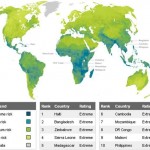Another example [1] involves the use of compressed natural gas in passenger cars in Brazil, where only about 13 per cent of the energy reaches the wheels. By contrast, if the gas is used to generate electricity to supply a plug-in electric vehicle, the energy efficiency is 32 percent (but see “The Biogas Economy Arrives” [6]) for a small modification of the car engine that makes natural gas more efficient than petrol.
UK company, ABB Ltd., demonstrated how electric motors that work at variable speeds as required – rather than at full throttle all the time – can deliver energy savings of 50 percent or more [7]. Electric motors are found in industrial fans, blowers and pumps, machine tools, household appliances, power tools and computer disc drives. “Two thirds of industry energy uses are due to motors,” says Nick Brown, ABB’s Energy Appraisal Manager. It is the easiest and most profitable way to help meet the UK government’s Credit Reduction Commitment (CRC) Energy Efficiency Scheme mandated by the Climate Change Act of 2008 that aims to reduce greenhouse gas emissions by 80 percent of 1990 level. CRC starts in 2010 in which companies must provide information on their energy use; 5,000 ‘fully participating companies’ with baseline energy consumption of 6,000 MWh/y or more will engage in a carbon trading scheme that also awards bonuses and exact penalties according to how well they have reduced their carbon footprint.
Another readily available energy efficiency improvement is LED (Light Emission Diode) lighting. LED technology is constantly getting better at delivering more and better quality light (> 2,000 lumens in multidie LEDs) for less than half the energy, being extraordinarily long-lasting (> 50,000 h life at 70 percent lumens), and requiring little or no maintenance, thereby saving both energy and maintenance costs substantially [8]. LED lightings have practically no hazardous materials such as mercury, cadmium or lead, which is a boon to end-of-life recycling. In addition, beautiful design features in buildings are now created with LED lighting that comes in many colours besides white.
It is estimated that 20 percent of the electricity use in the UK is on lighting, ahead of heating or ventilation. Apart from substantial carbon savings due to energy efficiency, the cost savings are such that the economic payback time for a typical installation is just 1.9 years. LED lighting is especially suited to off-grid use with small voltages locally generated from wind turbines, solar panels or biogas generators.
Sustainable Agriculture More Profitable and Saves Carbon Emissions
UNCTAD research has previously shown that farms which engaged in certified organic production in East Africa earned significantly more than comparable groups of farms engaged in conventional production. Between 2002 and 2007, global certified organic sales doubled to reach $46 billion, and are expected to increase further to $67 billion by 2012.
Despite the current economic crisis, demand for organic products is continuing to grow. While sales are concentrated in North America and Europe, production is global, with developing countries producing and exporting large and ever increasing shares. Africa, for instance, is home to some 20-24 per cent of the world’s certified organic farms. Exports of organic products from Uganda rose five-fold in five years, from $4.6 million in 2002/03 to $22.8 million in 2007/08. The price premiums for organic farmers range from 30 to 200 percent.
According to a recent report from FAO (United Nations Food and Agricultural Organization) [9], up to 5 of the 6.1 Gt of CO2e emissions from agriculture could be abated by phasing out chemical fertilizers – thereby saving CO2 emissions in the manufacture of fertilizers and reducing N2O emissions from the chemically fertilized soils – and by carbon sequestration in organically managed soils. This has been highlighted in ISIS’ earlier reports, which also dispelled the myth that organic agriculture results in reduced crop yields [3, 4] “Organic Agriculture and Localized Food & Energy Systems for Mitigating Climate Change”.
Actually, organic agriculture gives significantly greater crop yields especially in developing countries. In Europe and the United States, yields can decrease significantly during the first year of conversion from conventional to organic. However, organic crop yields tend to recover by year three, to equalize or overtake conventional crop yields. The big difference is that organic crops are much more resistant to drought, considerably out-yielding conventional crops during drought years, and recover much faster, being also more resilient.
All the evidence indicates that organically managed crops not only reduce costly and environmentally damaging input, reducing CO2 emissions and sequestering more carbon in the soil, they are also much better able to withstand the biotic and physical stresses of climate change. Organic agriculture is a key strategy for mitigating and adapting to climate change.
Off-Grid Renewables Available and Accessible
There are concrete examples of how off-grid renewable energy provides affordable and reliable power supply to improve people’s lives, create jobs, and fuel sustainable economic growth.

Grameen Shakti (GS) is a project initiated in 1996 in Bangladesh by the developers of Grameen Bank to provide rural people access to green energy at affordable costs [1, 10]. As a result, 220,000 homes across Bangladesh have installed photovoltaic (PV) systems. More than 8,000 PV systems are being installed a month and demand is increasing exponentially. The goal is to install 2 million PV systems in homes by 2011 and 7.5 million by 2015, which would serve half of the total rural population of Bangladesh.














